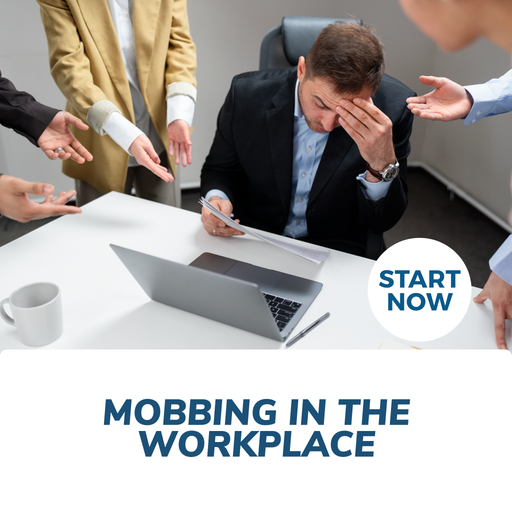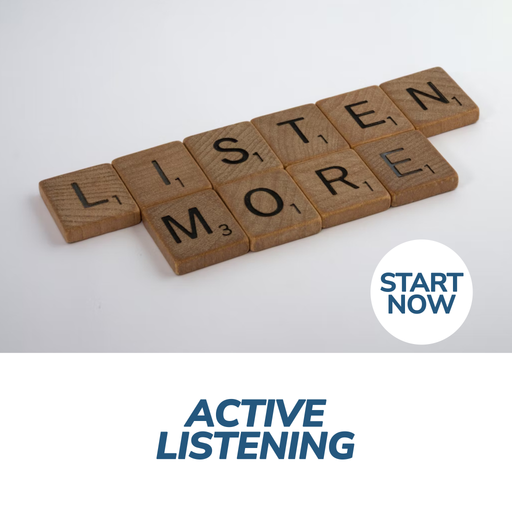
About This Course
What you will learn - Learn how to deal with mobbing and bullying
|
|
Get BIG Savings with our Mobbing in the Workplace Online Bundle, 5 Certificate Courses
- Mobbing in the Workplace
- Bullying in the Workplace
- Workplace Harassment
- How to Manage Anger and Violence in the Workplace
- Conflict Resolution: Getting Along In The Workplace
1. Mobbing in the Workplace: Learn how to deal with mobbing and bullying
What is Mobbing in the Workplace? You may be familiar with bullying, but mobbing is different for a few reasons. One of the things that sets it apart is how many people it involves, either by direct action or inaction, and how it spreads among people you might not expect to become bullies.
Key Learning Objectives
- Differences between bullying and mobbing
- Group aggression: How it hurts the victim and the workplace
- How to deal with bullying and mobbing
- How to make your workplace mobbing-resistant
- How to create a policy
2. Bullying in the Workplace: How to Avoid and Protect Yourself from Bullying
Bullying is called the silent epidemic. Although half of workers have experienced or witnessed bullying, policies and laws dealing with it are far less prevalent. This course will give you the tools to deal with workplace bullying.
In this Bullying in the Workplace course, you will learn what bullying is and what it can cost an organization. You will also learn how to protect yourself from bullying, what to do if you are bullied, and what to do if you witness bullying.
Key Learning Objectives
- Define what bullying is and is not.
- Understand the costs of bullying to people and organizations.
- Identify bullying behaviors and the reasons behind them.
- Know some ways to prevent bullying and understand what role you can play.
- Know some ways to protect yourself from bullying.
- Know what to do if you are bullied.
- Identify appropriate solutions for a bullying incident (within and outside the organization.)
- Assist in creating an anti-bullying policy.
3. Workplace Harassment: Learn To Recognize & Manage Workplace Harassment
Harassment can be based on a variety of factors such as race, sex, and disability. Experiencing an uncomfortable situation in the workplace may be more than an unpleasant event; it may be against the law. This alone is what makes this topic very important for every organization.
Our Workplace Harassment course will give you the tools to recognize harassment when it occurs. It will you understand rights and responsibilities, and create a safe environment for all. Through this course you will recognize that it is necessary for everyone to identify harassment and exercise anti-harassment policies.
Three main actions constitute harassment:
- When someone is doing something to you to make you uneasy.
- When someone is saying something to you to make you feel uneasy.
- When someone knowingly puts your life at risk in some way.
Key Learning Objectives
- Identify the words and actions that constitute harassment
- Understand what the law says about harassment
- Implement anti-harassment policies
- Educate employees and develop anti-harassment policies
- Discuss employer and employee's rights and responsibilities
- Address accusations of harassment
- Apply proper mediation procedures
- Deal with the aftermath of harassment
4. How to Manage Anger and Violence in the Workplace: Prevent Violence In The Workplace
Every organization must do whatever it can to prevent, identify, and mitigate workplace violence. This comprehensive course includes everything that you need to get started.
In this course, you will learn a nine-stage plan to help organizations prevent violence. You will also learn how to respond to violent incidents, manage anger, and implement design and hiring practices that will keep employees safe.
Key Learning Objectives
- Describe what workplace violence is.
- Identify some warning signs of violence.
- Apply the cycle of anger.
- Understand Albert Bandura’s behavior wheel and how it applies to anger.
- Develop a seven-step process for managing your anger and others’ anger.
- Apply better communication and problem solving skills, which will reduce frustration and anger.
- Develop some other ways of managing anger, including coping thoughts and relaxation techniques.
- Use the nine components of an organizational approach to managing anger, including risk assessment processes.
- Respond if a violent incident occurs in the workplace, on both an individual and organizational level.
5. Conflict Resolution: Getting Along In The Workplace: Learn different types of conflict, stages of conflict, helping others through conflict, and creating win/win solutions
Conflict is a necessary part of our personal growth and development. It only becomes an issue when the people involved cannot work through it. When this happens, negative energy can result, causing hurt feelings and damaged relationships. This course will teach you how to resolve conflict and gain positive results.
In this course, you will learn what conflict is all about. You will also learn about different types of conflict, stages of conflict, helping others through conflict, and creating win/win solutions. As a bonus, you will also learn supporting skills, such as communication, active listening, and body language.
Key Learning Objectives
- Understand what conflict is and how it can escalate.
- Understand the types of conflict and the stages of a conflict.
- Recognize the five most common conflict resolution styles and when to use them.
- Increase positive information flow through non-verbal and verbal communication skills.
- Develop effective techniques for intervention strategies.
- Become more confident of your ability to manage conflicts to enhance productivity and performance.
Receive Lifetime Access to Course Materials, so you can review at any time.
For comprehensive information on units of study click the units of study tab above.
This is an incredible opportunity to invest in yourself and your future, sharpen your training skills and learn what it takes to create your own success with Courses For Success Today!
Course Fast Facts:
- All courses are easy to follow and understand
- Only 6 to 8 hours of study is required per course
- Unlimited lifetime access to course materials
- Study as many courses as you want
- Delivered 100% on-line and accessible 24/7 from any computer or smartphone
- You can study from home or at work, at your own pace, in your own time
- Certificates
Course Delivery
Courses are accessed online via our learning management system by any device including PC, MAC, tablet or Smart Phone.
Recognition & Accreditation
The courses offered by Courses For Success are unique as they are taught in a step-by-step process enabling students to complete them quickly and easily, so that you can obtain your qualification sooner. All students who complete the course receive a certificate of completion. CoursesForSuccess is committed to high completion rates and therefore 100% student satisfaction.
Units of Study
Receive Lifetime Access to Course Materials, so you can review it at any time.
The Mobbing in the Workplace 5 Course Bundle includes the following courses, below is a summary of each course:
Course 1 - Mobbing in the Workplace Online Certificate Course
Session One: Course Overview
- Learning Objectives
- Pre-Assignment
- Pre-Course Assessment
Session Two: What is Mobbing?
- What and Why?
- A Mobbing Scenario
- Drawing Examples
- Stats
- Mobbing Reflection:
Session Three: Why Do We Turn on Each Other?
- Hierarchies
- Tendencies
- Influences
- Toxic Workplaces
Session Four: Mobbing Hurts
- How Does Mobbing Hurt?
- Reflection
Session Five: How to Deal with Mobbing
- As the Victim
- Stress Relief
- As a Co-worker
- Role Play Activity
Session Six: Watch For It
- What Can Leadership Do?
- Halting Mobbing
- Workplace Health Check
- A Reflection on Your Workplace
Session Seven: Make Your Own Policy
- Creating Anti-Mobbing Policies
- Writing the Policy
- Educating Staff
- Implementing and Enforcing Anti-Bullying Policies
- Pre-Assignment Review
- Lessons for the Workplace
- Personal Action Plan
- Course Summary
Course 2 - Bullying in the Workplace Online Certificate Course
Session 1: Course Overview
- Learning Objectives
- Pre-Assignment
Session 2: Defining Bullying
- What is Bullying?
- Some Scary Statistics
- Bullying is a Common Experience
- Common Targets
- The Costs of Bullying
- Costs to the Organization
Session 3: Why Bullies Do What They Do
- Origins of Bullying Behavior
- Defining Bullying Behavior
- Summary
- Other Types of Bullying
Session 4: Building a Shield Against Bullies
Distorted Thinking
- Your Toolkit Against Bullies
Session 5: What to Do If It Happens to You
- Telling it Like it Is
- When Does Bullying Happen?
- How Do I Know If I’m Being Bullied?
- Strategies That Don’t Work
- Short-Term Survival Tips
- Long-Term Strategies for Success
- Take Care of Priorities
- Take Time and Make a Plan
- Act!
- Applying My Skills
Session 6: What to Do If You Witness Bullying
- Speak Up!
- Case Study
- Things to Say
Session 7: Creating an Anti-Bullying Workplace
- Creating Anti-Bullying Policies
- Writing the Policy
- Educating Staff
- Implementing and Enforcing Anti-Bullying Policies
- Lessons for the Workplace, Questions 1 - 4
- Lessons for the Workplace, Questions 5 - 8
Session 8: The Law on Bullying
- The Law on Bullying Around the World
- A Personal Action Plan
- Starting Point
- Where I Want to Go
- How I Will Get There
Course 3 - Workplace Harassment Online Certificate Course
Module One - Getting Started
Module Two - The Background
- The law
- Identifying harassment
- Anti-harassment policies
Module Three - Developing an Anti-Harassment Policy
- An anti-harassment policy: What should be covered?
- How model policies work
- Steps to a healthy work place
- Educating employees
Module Four - Policies in the Workplace
- Anti-harassment policy statements
- Employee's rights and responsibilities
- Employer's rights and responsibilities
Module Five - Proper Procedures in the Workplace
- If you are being harassed
- If you are accused of harassing
- The investigation
- Remedies
Module Six - Fasle Allegations
- How to address the situation
- Confidentiality
- Monitoring the situation
- Retaliation
- Appeals
Module Seven - Other Options
- Union grievance procedures
- Mediation: Getting help from outside organisation
Module Eight - Sexual Harassment
- Defining sexual harassment
- Elements of harassment
- Common scenarios
Module Nine - Mediation
- What is mediation?
- Deciding if it's right
- How to implement
Module Ten - Conflict Resolution
- How to resolve the situation
- Seeing both sides
- Deciding the consequence
Module Eleven - The Aftermath
- How to move on
- Monitoring the situation
- Learning from mistakes
Module Twelve - Wrapping Up
Words from the Wise
- JOHN F. KENNEDY - One man can make a difference, and every man should try.
- NAPOLEON HILL - Victory is always possible for the person who refuses to stop fighting
- DR. MARTIN LUTHER KING JR - We must learn to live together as brothers or perish together as fools.
Course 4 - How to Manage Anger and Violence in the Workplace Online Certificate Course
Session 1: Course Overview
- Learning Objectives
- Pre-Assignment
Session 2: What is Workplace Violence?
- Defining Violence
- The Cycle of Violence
- The Warning Signs
- Maintaining Context
Session 3: Understanding the Behavior Wheel
- The Behavior Wheel
- Case Study
- Anger and the Behavior Wheel
Session 4: The Anger Management Process
- The Seven Steps
- Step One: Decide What to Do
- Step Two: Be Direct
- Mini Case Study
- Step Three: Acknowledge Feelings
- Step Four: Find Something in Common
- Step Five: Depersonalize
- Feedback vs. Attacks
- Responding Appropriately
- Mini Case Study
- Step Six: Getting to the Real Issues
- Case Study, Part One
- Case Study, Part Two
- Case Study, Part Three
- Case Study, Part Four
- Case Study, Part Five
- Letting Go, Part One
- Letting Go, Part Two
Session 5: Communicating Better
- Building Your Message
- I Messages
- The Assertiveness Formula
- Applying the Assertiveness Formula
- Making Connections
- Asking Questions
- Planning Your Questions
- Three Keys
Session 6: Basic Problem Solving Tools
- The Three-Phase Model
- The Problem Solving Model
- The Importance of the Model
- Another Perspective
- Keeping an Open Mind
- Solving Problems the Right Way
- Phase One
- Perception
- Definition
- Analysis, Part One
- Analysis, Part Two
- Analysis, Part Three
- Phase Two
- Creative Thinking Methods
- Checkerboard
- Research and Report
- Evaluation
- Decision Making
- Phase Three
- Planning
- Implementation
- Solution Planning Worksheet
- The Problem Solving Toolkit
- Using Criteria
- Force Field Analysis
- Legitimizing Problems and Positions
- Task Information
- Skill Application
- Phase Two: Decision Making
- Phase Three: Planning and Organizing
Session 7: Other Ways of Managing Anger
- Coping Strategies
- Sanctuary
- Relaxation Techniques
Session 8: A Systems Approach
- The Nine Stage Plan
Session 9: Developing a Policy and Program
- The Policy: The Purpose
- The Policy: The Elements
- The Policy: Staff Responsibilities
- The Programs
Session 10: Risk Assessment
- The Five Stages
- Stage One: The Risk Assessment Team
- Stage Two: The Workplace Assessment
- Stage Three, Part One: Victim Assessment
- Stage Three, Part Two: Perpetrator Assessment
- Red Flags
- Stage Four: Workplace Survey
- Stage Five: Developing a Hazard Checklist
- Part One: Case Study (Summary)
- Part One: Case Study (Floor Plan)
- Part One: Case Study (Staff Hours)
- Part Two: Risk Assessment (Workplace Assessment)
- Part Two: Risk Assessment (Victim Assessment)
- Part Two: Risk Assessment (Perpetrator Assessment)
- Part Two: Risk Assessment (Workplace Survey)
- Part Two: Risk Assessment (Hazard Checklist)
Session 11: Hiring Practices
- Getting it Right
- Key Strategies
- Checking Tests Out
Session 12: Workplace Design
- Layout Issues with the Acme Widgets Company: Case Study
- Task
Session 13: Workplace Practices and Procedures
- Workplace Policies
- Human Resources
- Staff Management
- Security Measures
- Workplace Procedures
Session 14: Security Systems and Personnel
- Systems Criteria
- Security Systems, Part One
- Security Systems, Part Two
- Security Personnel
- Case Study: Staffing Schedule
- Case Study: Floor Plan
- Task
Session 15: Training Programs
- Developing a Program
- Contents of the Program
- Summary
Session 16: Developing Emergency Response Plans
- Guide to Developing a Plan
- People to Include
- Items to Address
- Case Study: Summary
- Case Study: Floor Plan
- Case Study: Staff Hours
- Case Study: Security Systems
- Task
Session 17: Program Review
- Review Components
Session 18: Developing a Threat Response Process
- Introduction
- The 14 Stages
- The Threat Review Team
Session 19: The Immediate Response
- What To Do When Violence Happens
- Next Steps
- Stage One of the Threat Response Process, Part One
- Stage One of the Threat Response Process, Part Two
- Case Study
- Questions, Part One
- Questions, Part Two
- Questions, Part Three
- Questions, Part Four
Session 20: Consulting with the Experts
- Stage Two
Session 21: Gathering Additional Information
- Gathering Information
- Case Study
- Questions, Part One
- Questions, Part Two
- Questions, Part Three
Session 22: Re-Evaluating Information
- Stage Four
- Stage Five
Session 23: Communicating Incidents and Threats
- Stage Six, Part One
- Stage Six, Part Two
- Developing a Communication Plan
- Staff List
- Questions
Session 24: Interviewing Employees
- Stage Seven
- Stage Eight
- Making Connections
- Task
Session 25: Risk Level Analysis
- Stage Nine
- The Five Categories
- Case Studies, Part One
- Case Studies, Part Two
Session 26: Reviewing the Options
- Stage Ten
- Possible Outcomes
- About Termination
- Stages Eleven, Twelve, and Thirteen
Session 27: Analyzing the Impact
- About Stage Fourteen
- Debriefing for the Threat Assessment Team
- Helping the Healing
Session 28: Incident Response Checklist
- Framework Checklist, Part One
- Framework Checklist, Part Two
- Framework Checklist, Part Three
- Framework Checklist, Part Four
- Framework Checklist, Part Five
- Framework Checklist, Part Six
- Framework Checklist, Part Seven
- Framework Checklist, Part Eight
- Framework Checklist, Part Nine
- Framework Checklist, Part Ten
- Framework Checklist, Part Eleven
- Framework Checklist, Part Twelve
- Framework Checklist, Part Thirteen
- Framework Checklist, Part Fourteen
- Framework Checklist, Part Fifteen
- Framework Checklist, Part Sixteen
Session 29: Process Application
- Reviewing the Process, Part One
- Reviewing the Process, Part Two
- Reviewing the Process, Part Three
- Reviewing the Process, Part Four
- Reviewing the Process, Part Five
Session 30: A Personal Action Plan
- Starting Point
- Where I Want to Go
- How I Will Get There
Course 5 - Conflict Resolution: Getting Along In The Workplace Online Certificate Course
Session One: Course Overview
Session Two: Defining Conflict
- What is Conflict?
- Positives and Negatives
Session Three: Types of Conflict
Session Four: Open Conflict vs. Hidden Conflict
Session Five: Spontaneous and Reflective Behavior
Session Six: The Johari Window
- Understanding the Johari Window
- My Window
- Case Study: Spontaneous and Reflective Behaviors
Session Seven: Stages of Conflict
- The Five Stages of Conflict
- Another Version of the Conflict Process
- Conflict Outcomes
- Strategies for Dealing with Conflict
Session Eight: Creating the Win/Win
Session Nine: Conflict Resolution Style Questionnaire
- The Questionnaire
- Scoring
- The Conflict Grid
- Pros and Cons
Session Ten: The Role of Communication in Conflict Resolution
- The Communication Chain
- Other Barriers
- Establishing Positive Intent
Session Eleven: Active Listening Skills
Session Twelve: Paraphrasing Skills
- What is Paraphrasing?
- Making Connections
Session Thirteen: Powerful Questions
- Asking Questions
- Probing Techniques
Session Fourteen: Body Language
Session Fifteen: Pre-Assignment Review
Session Sixteen: The Conflict/Opportunity Test
- The Conflict/Opportunity Test
- Skills Test
Session Seventeen: Conflict and Its Resolution
- Visualizing Conflict
- A Strategy for Conflict Resolution
Session Eighteen: Helping Others Through Conflict
- Preparing for Conflict
- Conflict Resolution with Facilitation
- Setting Norms
- Coaching Through Conflict
- Managing Your Emotions
Requirements
Entry requirements
Students must have basic literacy and numeracy skills.
Minimum education
Open entry. Previous schooling and academic achievements are not required for entry into this course.
Computer requirements
Students will need access to a computer and the internet.
Minimum specifications for the computer are:
Windows:
Microsoft Windows XP, or laterModern and up to date Browser (Internet Explorer 8 or later, Firefox, Chrome, Safari)
MAC/iOS
OSX/iOS 6 or laterModern and up to date Browser (Firefox, Chrome, Safari)
All systems
Internet bandwidth of 1Mb or fasterFlash player or a browser with HTML5 video capabilities(Currently Internet Explorer 9, Firefox, Chrome, Safari)
Students will also need access the following applications:
Adobe Acrobat Reader
Requirements
Entry requirements:
Students must have basic literacy and numeracy skills.
Minimum education:
Open entry. Previous schooling and academic achievements are not required for entry into this course.
Device requirements:
Students will need access to a computer/any device and the internet.
FAQS
1. Who are Courses For Success?
Courses For Success is a course platform that started in 2008
with 5 courses, since then we have grown to over 10,000 online courses.
Our courses span across the following categories:
•Animal
•Beauty
•Business
•Health & Fitness
•Finance
•Lifestyle
•IT & Software
•Personal Development
•Teaching & Academics
2. Is there a refund/cancellation policy?
Yes, we have a 7-day money-back refund policy.
3. What is the FREE 10 Soft Skills You Need Course?
The 10 Soft Skills You Need Course was developed by Courses For Success to help our customers achieve
success. Currently, we are offering this program for FREE with every
course or bundle purchase this month. This is a limited time offer!
4. Are there any requirements to study this course?
No,
anyone who has an interest in learning more about this subject matter
is encouraged to take our course. There are no entry requirements to
take this course.
5. Do I require to have finished high school to complete this course?
No,
you do not require a High School Diploma or to have finished school to
study this course, this course is open to anyone who would like to take
this course.
6. What if English is not my first language?
This
course is provided in English, however, due to the digital nature of
our training, you can take your time studying the material and make use
of tools such as google translate and Grammarly.
7. Is this course online or conducted in person?
All our courses are accessible online on any device. You may complete them at your own pace and at your own time.
8. How do I receive my course?
After
you have completed the payment, you will receive a confirmation email
and tax receipt. You will also receive an email containing your course
login details (username and password), as well as instructions on how to
access and log in to your course via the internet with any device,
please check your junk/spam folder in the event that you do not receive
the email.
9. When does this course start?
Providing
you have internet access you can start this course whenever you like,
just go to the login page and insert your username and password and you
can access the online material.
10. What is online learning like?
Online learning is easy, if not easier than a traditional academic situation.
By studying an online course, the usual boundaries caused by location and time constraints are eliminated, meaning you are free to study where and when you want at your own pace.
Of course, you will need to be able to self-manage your time and be organized, but with our help, you’ll soon find yourself settling into a comfortable rhythm of study.
11. What computer skills do I need for my course?
You
don't need to be a computer expert to succeed with our online training,
but you should be comfortable typing, using the internet and be capable
of using common software (such as Microsoft word).
12. How long will you have access to the online course?
The majority of our courses have unlimited lifetime access, meaning you can access this course whenever you want.
Please also check the course summary, as a small selection of courses have limited access.
13. How long will my course take?
Course duration, is listed under Course Summary
14. Do I need to buy textbooks?
All the required material for your course is included in the online system, you do not need to buy anything else.
15. Is the course interactive?
Yes, all our courses are interactive.
16. Is there an assessment or exam?
Yes,
you will be required to complete a multiple-choice test online at the
end of your course, you can do this test as many times as you require.
17. What type of certificate will I receive?
You
will receive a Certificate of Completion that is applicable worldwide,
which demonstrates your commitment to learning new skills. You can share
the certificate with your friends, relatives, co-workers and employers.
Also, include it in your resume/CV, professional social media profiles
and job applications.
Wendy Sue Hunt - 5 STAR REVIEW
"If you are considering taking any “Courses for Success”, I would highly recommend it. I have always been a firm believer it’s important to always sharpen your skills. You are never too old to learn more. I found the courses very helpful, interesting and easy to understand.
The term “Courses for Success” helped me in my current position to succeed. After completing the courses, I gave my manager the completion certificates. Recently I received a promotion too."
Valencia Marie Aviles - 5 STAR REVIEW
"I
had a very good experience with my course. It has helped me to get
multiple jobs and prepared me for almost everything I would need to
know. The course was very informative and easy to understand and broken
up perfectly to be done in a short amount of time while still learning a
good amount! I would recommend Courses for Success to anyone trying to
get abs certifications for job advancements, it is well worth it!"
ELENA GRIFFIN - 5 STAR REVIEW
"I have absolutely enjoyed the materials from Courses for Success. The materials are easy to understand which makes learning enjoyable. Courses for Success have great topics of interest which make you come back for
more.
Thank you Courses for Success for being part of my learning journey and making education affordable!"
Our
completion certificates are very valuable and will help you progress in
your work environment and show employers how committed you are to learn
new skills, you might even get a promotion.
18. Will this course be credited by universities?
No, it is not equivalent to a college or university credit.
19. Am I guaranteed to get a job with this certificate?
This course will give you the skills you need to help you obtain employment, but it’s up to you if you get the job or not.
20. How will this course assist me with my career?
Studying
and completing this course will show employers that you have the
knowledge in this field, additionally you will gain more confidence in
this area of expertise.
21. How long is the certificate valid for?
The Certificates are valid for life and do not need renewing.
22. Can I take more than one course at a time?
Courses
are studied online at your own pace and you are free to study as many
or as few courses as you wish, we also offer online course bundles that
allow you to save on additional courses so that you may get all the
topics related to your training goals in one go.
23. What are the Payment Methods available? Is there a payment plan?
We accept payments via PayPal, Credit Card and Bank Transfer.
Payment Plans: We have partnered with Partial.ly, to offer our own in house payment plan. Everyone is Pre-Approved, providing the initial deposit is paid in full.
To pay via bank transfer contact us info@coursesforsuccess.com
24. Can I purchase for multiple people?
Yes, you can do this by purchasing individually via website or send us a request via email at info@coursesforsuccess.com
25. Can I request for an invoice before purchase?
Yes, you can request for an invoice via email at info@coursesforsuccess.com
26. Purchase for a gift?
Yes, you can purchase this course as a gift, simply send an email to info@coursesforsuccess.com, with the course details and we can accommodate this.
27. Can I create my own course bundle?
Yes,
you can customize your own bundle. Please send us the complete list
with the exact course link of the courses you'd like to bundle up via
email info@coursesforsuccess.com and we will create them for you. *Each course access, time of completion and certification varies depending on the course type.
28. How will I contact Courses For Success if I have any questions?
You can contact our support team, at any time through live chat on our website, or email at info@coursesforsuccess.com, or by calling one of our phone numbers depending on which country you are in.
SANTA DISCOUNTS & FREE UPGRADES - OFFER ENDS MIDNIGHT TODAY
SAVE BIG ON COURSES & EVEN BIGGER ON BUNDLES - PLUS GET A FREE UPGRADE TO THE NEXT BUNDLE - HURRY DISCOUNTS ENDS MIDNIGHT TODAY!
Save Big:
- INDIVIDUAL COURSES - SAVE UP TO 50% + FREE UPGRADE TO 2 COURSE BUNDLE
- 2 COURSE BUNDLE - SAVE UP TO 81% + FREE UPGRADE TO 3 COURSE BUNDLE
- 3 COURSE BUNDLE - SAVE UP TO 85% + FREE UPGRADE TO 5 COURSE BUNDLE
- 5 COURSE BUNDLE - SAVE UP TO 89% + FREE UPGRADE TO 10 COURSE BUNDLE
- 10 COURSE BUNDLE - SAVE UP TO 91%
THE MORE YOU BUY THE MORE YOU SAVE
OR BUY THE MEGA BUNDLE & SAVE 97%
The Mega Bundle provides lifetime access to 400 plus courses – equip yourself with the skills you need – invest in your future today!
BUILD YOUR OWN BUNDLE & SAVE 30%-75%
In addition, we also enable you to select your own courses and add these to your own bundle whereby the more you add the more you save.
Course Bundles
Looking for specific training for yourself or employees. Choose from our Course Bundles below or build you own Bundle, by adding more courses to your cart. Choose different courses or the same course for multiple staff members and receive volume discounts at checkout.
Mobbing in the Workplace Online Bundle, 5 Certificate Courses
Build the skills needed to address aggression, mediate conflicts, and reduce tension before it escalates. This bundle helps leaders and HR professionals promote positive communication and maintain a psychologically safe workplace.
Courses Included:
- Mobbing in the Workplace
- Bullying in the Workplace
- Workplace Harassment
- How to Manage Anger and Violence in the Workplace
- Conflict Resolution: Getting Along In The Workplace
Bundle Up & Save - Learn More and Save More when you Upgrade to one of our Course Bundles below - Save Up To 97%
Course Summary
- Delivery: Online
- Access: Unlimited Lifetime
- Time: Study at your own pace
- Duration: 6 to 8 hours per course
- Assessments: Yes
- Qualification: Certificate
SANTA DISCOUNTS & FREE UPGRADES!
HURRY DISCOUNTS END MIDNIGHT TODAY!
About This Course
What you will learn - Learn how to deal with mobbing and bullying
|
|
Get BIG Savings with our Mobbing in the Workplace Online Bundle, 5 Certificate Courses
- Mobbing in the Workplace
- Bullying in the Workplace
- Workplace Harassment
- How to Manage Anger and Violence in the Workplace
- Conflict Resolution: Getting Along In The Workplace
1. Mobbing in the Workplace: Learn how to deal with mobbing and bullying
What is Mobbing in the Workplace? You may be familiar with bullying, but mobbing is different for a few reasons. One of the things that sets it apart is how many people it involves, either by direct action or inaction, and how it spreads among people you might not expect to become bullies.
Key Learning Objectives
- Differences between bullying and mobbing
- Group aggression: How it hurts the victim and the workplace
- How to deal with bullying and mobbing
- How to make your workplace mobbing-resistant
- How to create a policy
2. Bullying in the Workplace: How to Avoid and Protect Yourself from Bullying
Bullying is called the silent epidemic. Although half of workers have experienced or witnessed bullying, policies and laws dealing with it are far less prevalent. This course will give you the tools to deal with workplace bullying.
In this Bullying in the Workplace course, you will learn what bullying is and what it can cost an organization. You will also learn how to protect yourself from bullying, what to do if you are bullied, and what to do if you witness bullying.
Key Learning Objectives
- Define what bullying is and is not.
- Understand the costs of bullying to people and organizations.
- Identify bullying behaviors and the reasons behind them.
- Know some ways to prevent bullying and understand what role you can play.
- Know some ways to protect yourself from bullying.
- Know what to do if you are bullied.
- Identify appropriate solutions for a bullying incident (within and outside the organization.)
- Assist in creating an anti-bullying policy.
3. Workplace Harassment: Learn To Recognize & Manage Workplace Harassment
Harassment can be based on a variety of factors such as race, sex, and disability. Experiencing an uncomfortable situation in the workplace may be more than an unpleasant event; it may be against the law. This alone is what makes this topic very important for every organization.
Our Workplace Harassment course will give you the tools to recognize harassment when it occurs. It will you understand rights and responsibilities, and create a safe environment for all. Through this course you will recognize that it is necessary for everyone to identify harassment and exercise anti-harassment policies.
Three main actions constitute harassment:
- When someone is doing something to you to make you uneasy.
- When someone is saying something to you to make you feel uneasy.
- When someone knowingly puts your life at risk in some way.
Key Learning Objectives
- Identify the words and actions that constitute harassment
- Understand what the law says about harassment
- Implement anti-harassment policies
- Educate employees and develop anti-harassment policies
- Discuss employer and employee's rights and responsibilities
- Address accusations of harassment
- Apply proper mediation procedures
- Deal with the aftermath of harassment
4. How to Manage Anger and Violence in the Workplace: Prevent Violence In The Workplace
Every organization must do whatever it can to prevent, identify, and mitigate workplace violence. This comprehensive course includes everything that you need to get started.
In this course, you will learn a nine-stage plan to help organizations prevent violence. You will also learn how to respond to violent incidents, manage anger, and implement design and hiring practices that will keep employees safe.
Key Learning Objectives
- Describe what workplace violence is.
- Identify some warning signs of violence.
- Apply the cycle of anger.
- Understand Albert Bandura’s behavior wheel and how it applies to anger.
- Develop a seven-step process for managing your anger and others’ anger.
- Apply better communication and problem solving skills, which will reduce frustration and anger.
- Develop some other ways of managing anger, including coping thoughts and relaxation techniques.
- Use the nine components of an organizational approach to managing anger, including risk assessment processes.
- Respond if a violent incident occurs in the workplace, on both an individual and organizational level.
5. Conflict Resolution: Getting Along In The Workplace: Learn different types of conflict, stages of conflict, helping others through conflict, and creating win/win solutions
Conflict is a necessary part of our personal growth and development. It only becomes an issue when the people involved cannot work through it. When this happens, negative energy can result, causing hurt feelings and damaged relationships. This course will teach you how to resolve conflict and gain positive results.
In this course, you will learn what conflict is all about. You will also learn about different types of conflict, stages of conflict, helping others through conflict, and creating win/win solutions. As a bonus, you will also learn supporting skills, such as communication, active listening, and body language.
Key Learning Objectives
- Understand what conflict is and how it can escalate.
- Understand the types of conflict and the stages of a conflict.
- Recognize the five most common conflict resolution styles and when to use them.
- Increase positive information flow through non-verbal and verbal communication skills.
- Develop effective techniques for intervention strategies.
- Become more confident of your ability to manage conflicts to enhance productivity and performance.
Receive Lifetime Access to Course Materials, so you can review at any time.
For comprehensive information on units of study click the units of study tab above.
This is an incredible opportunity to invest in yourself and your future, sharpen your training skills and learn what it takes to create your own success with Courses For Success Today!
Course Fast Facts:
- All courses are easy to follow and understand
- Only 6 to 8 hours of study is required per course
- Unlimited lifetime access to course materials
- Study as many courses as you want
- Delivered 100% on-line and accessible 24/7 from any computer or smartphone
- You can study from home or at work, at your own pace, in your own time
- Certificates
Course Delivery
Courses are accessed online via our learning management system by any device including PC, MAC, tablet or Smart Phone.
Recognition & Accreditation
The courses offered by Courses For Success are unique as they are taught in a step-by-step process enabling students to complete them quickly and easily, so that you can obtain your qualification sooner. All students who complete the course receive a certificate of completion. CoursesForSuccess is committed to high completion rates and therefore 100% student satisfaction.
Units of Study
Receive Lifetime Access to Course Materials, so you can review it at any time.
The Mobbing in the Workplace 5 Course Bundle includes the following courses, below is a summary of each course:
Course 1 - Mobbing in the Workplace Online Certificate Course
Session One: Course Overview
- Learning Objectives
- Pre-Assignment
- Pre-Course Assessment
Session Two: What is Mobbing?
- What and Why?
- A Mobbing Scenario
- Drawing Examples
- Stats
- Mobbing Reflection:
Session Three: Why Do We Turn on Each Other?
- Hierarchies
- Tendencies
- Influences
- Toxic Workplaces
Session Four: Mobbing Hurts
- How Does Mobbing Hurt?
- Reflection
Session Five: How to Deal with Mobbing
- As the Victim
- Stress Relief
- As a Co-worker
- Role Play Activity
Session Six: Watch For It
- What Can Leadership Do?
- Halting Mobbing
- Workplace Health Check
- A Reflection on Your Workplace
Session Seven: Make Your Own Policy
- Creating Anti-Mobbing Policies
- Writing the Policy
- Educating Staff
- Implementing and Enforcing Anti-Bullying Policies
- Pre-Assignment Review
- Lessons for the Workplace
- Personal Action Plan
- Course Summary
Course 2 - Bullying in the Workplace Online Certificate Course
Session 1: Course Overview
- Learning Objectives
- Pre-Assignment
Session 2: Defining Bullying
- What is Bullying?
- Some Scary Statistics
- Bullying is a Common Experience
- Common Targets
- The Costs of Bullying
- Costs to the Organization
Session 3: Why Bullies Do What They Do
- Origins of Bullying Behavior
- Defining Bullying Behavior
- Summary
- Other Types of Bullying
Session 4: Building a Shield Against Bullies
Distorted Thinking
- Your Toolkit Against Bullies
Session 5: What to Do If It Happens to You
- Telling it Like it Is
- When Does Bullying Happen?
- How Do I Know If I’m Being Bullied?
- Strategies That Don’t Work
- Short-Term Survival Tips
- Long-Term Strategies for Success
- Take Care of Priorities
- Take Time and Make a Plan
- Act!
- Applying My Skills
Session 6: What to Do If You Witness Bullying
- Speak Up!
- Case Study
- Things to Say
Session 7: Creating an Anti-Bullying Workplace
- Creating Anti-Bullying Policies
- Writing the Policy
- Educating Staff
- Implementing and Enforcing Anti-Bullying Policies
- Lessons for the Workplace, Questions 1 - 4
- Lessons for the Workplace, Questions 5 - 8
Session 8: The Law on Bullying
- The Law on Bullying Around the World
- A Personal Action Plan
- Starting Point
- Where I Want to Go
- How I Will Get There
Course 3 - Workplace Harassment Online Certificate Course
Module One - Getting Started
Module Two - The Background
- The law
- Identifying harassment
- Anti-harassment policies
Module Three - Developing an Anti-Harassment Policy
- An anti-harassment policy: What should be covered?
- How model policies work
- Steps to a healthy work place
- Educating employees
Module Four - Policies in the Workplace
- Anti-harassment policy statements
- Employee's rights and responsibilities
- Employer's rights and responsibilities
Module Five - Proper Procedures in the Workplace
- If you are being harassed
- If you are accused of harassing
- The investigation
- Remedies
Module Six - Fasle Allegations
- How to address the situation
- Confidentiality
- Monitoring the situation
- Retaliation
- Appeals
Module Seven - Other Options
- Union grievance procedures
- Mediation: Getting help from outside organisation
Module Eight - Sexual Harassment
- Defining sexual harassment
- Elements of harassment
- Common scenarios
Module Nine - Mediation
- What is mediation?
- Deciding if it's right
- How to implement
Module Ten - Conflict Resolution
- How to resolve the situation
- Seeing both sides
- Deciding the consequence
Module Eleven - The Aftermath
- How to move on
- Monitoring the situation
- Learning from mistakes
Module Twelve - Wrapping Up
Words from the Wise
- JOHN F. KENNEDY - One man can make a difference, and every man should try.
- NAPOLEON HILL - Victory is always possible for the person who refuses to stop fighting
- DR. MARTIN LUTHER KING JR - We must learn to live together as brothers or perish together as fools.
Course 4 - How to Manage Anger and Violence in the Workplace Online Certificate Course
Session 1: Course Overview
- Learning Objectives
- Pre-Assignment
Session 2: What is Workplace Violence?
- Defining Violence
- The Cycle of Violence
- The Warning Signs
- Maintaining Context
Session 3: Understanding the Behavior Wheel
- The Behavior Wheel
- Case Study
- Anger and the Behavior Wheel
Session 4: The Anger Management Process
- The Seven Steps
- Step One: Decide What to Do
- Step Two: Be Direct
- Mini Case Study
- Step Three: Acknowledge Feelings
- Step Four: Find Something in Common
- Step Five: Depersonalize
- Feedback vs. Attacks
- Responding Appropriately
- Mini Case Study
- Step Six: Getting to the Real Issues
- Case Study, Part One
- Case Study, Part Two
- Case Study, Part Three
- Case Study, Part Four
- Case Study, Part Five
- Letting Go, Part One
- Letting Go, Part Two
Session 5: Communicating Better
- Building Your Message
- I Messages
- The Assertiveness Formula
- Applying the Assertiveness Formula
- Making Connections
- Asking Questions
- Planning Your Questions
- Three Keys
Session 6: Basic Problem Solving Tools
- The Three-Phase Model
- The Problem Solving Model
- The Importance of the Model
- Another Perspective
- Keeping an Open Mind
- Solving Problems the Right Way
- Phase One
- Perception
- Definition
- Analysis, Part One
- Analysis, Part Two
- Analysis, Part Three
- Phase Two
- Creative Thinking Methods
- Checkerboard
- Research and Report
- Evaluation
- Decision Making
- Phase Three
- Planning
- Implementation
- Solution Planning Worksheet
- The Problem Solving Toolkit
- Using Criteria
- Force Field Analysis
- Legitimizing Problems and Positions
- Task Information
- Skill Application
- Phase Two: Decision Making
- Phase Three: Planning and Organizing
Session 7: Other Ways of Managing Anger
- Coping Strategies
- Sanctuary
- Relaxation Techniques
Session 8: A Systems Approach
- The Nine Stage Plan
Session 9: Developing a Policy and Program
- The Policy: The Purpose
- The Policy: The Elements
- The Policy: Staff Responsibilities
- The Programs
Session 10: Risk Assessment
- The Five Stages
- Stage One: The Risk Assessment Team
- Stage Two: The Workplace Assessment
- Stage Three, Part One: Victim Assessment
- Stage Three, Part Two: Perpetrator Assessment
- Red Flags
- Stage Four: Workplace Survey
- Stage Five: Developing a Hazard Checklist
- Part One: Case Study (Summary)
- Part One: Case Study (Floor Plan)
- Part One: Case Study (Staff Hours)
- Part Two: Risk Assessment (Workplace Assessment)
- Part Two: Risk Assessment (Victim Assessment)
- Part Two: Risk Assessment (Perpetrator Assessment)
- Part Two: Risk Assessment (Workplace Survey)
- Part Two: Risk Assessment (Hazard Checklist)
Session 11: Hiring Practices
- Getting it Right
- Key Strategies
- Checking Tests Out
Session 12: Workplace Design
- Layout Issues with the Acme Widgets Company: Case Study
- Task
Session 13: Workplace Practices and Procedures
- Workplace Policies
- Human Resources
- Staff Management
- Security Measures
- Workplace Procedures
Session 14: Security Systems and Personnel
- Systems Criteria
- Security Systems, Part One
- Security Systems, Part Two
- Security Personnel
- Case Study: Staffing Schedule
- Case Study: Floor Plan
- Task
Session 15: Training Programs
- Developing a Program
- Contents of the Program
- Summary
Session 16: Developing Emergency Response Plans
- Guide to Developing a Plan
- People to Include
- Items to Address
- Case Study: Summary
- Case Study: Floor Plan
- Case Study: Staff Hours
- Case Study: Security Systems
- Task
Session 17: Program Review
- Review Components
Session 18: Developing a Threat Response Process
- Introduction
- The 14 Stages
- The Threat Review Team
Session 19: The Immediate Response
- What To Do When Violence Happens
- Next Steps
- Stage One of the Threat Response Process, Part One
- Stage One of the Threat Response Process, Part Two
- Case Study
- Questions, Part One
- Questions, Part Two
- Questions, Part Three
- Questions, Part Four
Session 20: Consulting with the Experts
- Stage Two
Session 21: Gathering Additional Information
- Gathering Information
- Case Study
- Questions, Part One
- Questions, Part Two
- Questions, Part Three
Session 22: Re-Evaluating Information
- Stage Four
- Stage Five
Session 23: Communicating Incidents and Threats
- Stage Six, Part One
- Stage Six, Part Two
- Developing a Communication Plan
- Staff List
- Questions
Session 24: Interviewing Employees
- Stage Seven
- Stage Eight
- Making Connections
- Task
Session 25: Risk Level Analysis
- Stage Nine
- The Five Categories
- Case Studies, Part One
- Case Studies, Part Two
Session 26: Reviewing the Options
- Stage Ten
- Possible Outcomes
- About Termination
- Stages Eleven, Twelve, and Thirteen
Session 27: Analyzing the Impact
- About Stage Fourteen
- Debriefing for the Threat Assessment Team
- Helping the Healing
Session 28: Incident Response Checklist
- Framework Checklist, Part One
- Framework Checklist, Part Two
- Framework Checklist, Part Three
- Framework Checklist, Part Four
- Framework Checklist, Part Five
- Framework Checklist, Part Six
- Framework Checklist, Part Seven
- Framework Checklist, Part Eight
- Framework Checklist, Part Nine
- Framework Checklist, Part Ten
- Framework Checklist, Part Eleven
- Framework Checklist, Part Twelve
- Framework Checklist, Part Thirteen
- Framework Checklist, Part Fourteen
- Framework Checklist, Part Fifteen
- Framework Checklist, Part Sixteen
Session 29: Process Application
- Reviewing the Process, Part One
- Reviewing the Process, Part Two
- Reviewing the Process, Part Three
- Reviewing the Process, Part Four
- Reviewing the Process, Part Five
Session 30: A Personal Action Plan
- Starting Point
- Where I Want to Go
- How I Will Get There
Course 5 - Conflict Resolution: Getting Along In The Workplace Online Certificate Course
Session One: Course Overview
Session Two: Defining Conflict
- What is Conflict?
- Positives and Negatives
Session Three: Types of Conflict
Session Four: Open Conflict vs. Hidden Conflict
Session Five: Spontaneous and Reflective Behavior
Session Six: The Johari Window
- Understanding the Johari Window
- My Window
- Case Study: Spontaneous and Reflective Behaviors
Session Seven: Stages of Conflict
- The Five Stages of Conflict
- Another Version of the Conflict Process
- Conflict Outcomes
- Strategies for Dealing with Conflict
Session Eight: Creating the Win/Win
Session Nine: Conflict Resolution Style Questionnaire
- The Questionnaire
- Scoring
- The Conflict Grid
- Pros and Cons
Session Ten: The Role of Communication in Conflict Resolution
- The Communication Chain
- Other Barriers
- Establishing Positive Intent
Session Eleven: Active Listening Skills
Session Twelve: Paraphrasing Skills
- What is Paraphrasing?
- Making Connections
Session Thirteen: Powerful Questions
- Asking Questions
- Probing Techniques
Session Fourteen: Body Language
Session Fifteen: Pre-Assignment Review
Session Sixteen: The Conflict/Opportunity Test
- The Conflict/Opportunity Test
- Skills Test
Session Seventeen: Conflict and Its Resolution
- Visualizing Conflict
- A Strategy for Conflict Resolution
Session Eighteen: Helping Others Through Conflict
- Preparing for Conflict
- Conflict Resolution with Facilitation
- Setting Norms
- Coaching Through Conflict
- Managing Your Emotions
Requirements
Entry requirements
Students must have basic literacy and numeracy skills.
Minimum education
Open entry. Previous schooling and academic achievements are not required for entry into this course.
Computer requirements
Students will need access to a computer and the internet.
Minimum specifications for the computer are:
Windows:
Microsoft Windows XP, or laterModern and up to date Browser (Internet Explorer 8 or later, Firefox, Chrome, Safari)
MAC/iOS
OSX/iOS 6 or laterModern and up to date Browser (Firefox, Chrome, Safari)
All systems
Internet bandwidth of 1Mb or fasterFlash player or a browser with HTML5 video capabilities(Currently Internet Explorer 9, Firefox, Chrome, Safari)
Students will also need access the following applications:
Adobe Acrobat Reader
Requirements
Entry requirements:
Students must have basic literacy and numeracy skills.
Minimum education:
Open entry. Previous schooling and academic achievements are not required for entry into this course.
Device requirements:
Students will need access to a computer/any device and the internet.
FAQS
1. Who are Courses For Success?
Courses For Success is a course platform that started in 2008
with 5 courses, since then we have grown to over 10,000 online courses.
Our courses span across the following categories:
•Animal
•Beauty
•Business
•Health & Fitness
•Finance
•Lifestyle
•IT & Software
•Personal Development
•Teaching & Academics
2. Is there a refund/cancellation policy?
Yes, we have a 7-day money-back refund policy.
3. What is the FREE 10 Soft Skills You Need Course?
The 10 Soft Skills You Need Course was developed by Courses For Success to help our customers achieve
success. Currently, we are offering this program for FREE with every
course or bundle purchase this month. This is a limited time offer!
4. Are there any requirements to study this course?
No,
anyone who has an interest in learning more about this subject matter
is encouraged to take our course. There are no entry requirements to
take this course.
5. Do I require to have finished high school to complete this course?
No,
you do not require a High School Diploma or to have finished school to
study this course, this course is open to anyone who would like to take
this course.
6. What if English is not my first language?
This
course is provided in English, however, due to the digital nature of
our training, you can take your time studying the material and make use
of tools such as google translate and Grammarly.
7. Is this course online or conducted in person?
All our courses are accessible online on any device. You may complete them at your own pace and at your own time.
8. How do I receive my course?
After
you have completed the payment, you will receive a confirmation email
and tax receipt. You will also receive an email containing your course
login details (username and password), as well as instructions on how to
access and log in to your course via the internet with any device,
please check your junk/spam folder in the event that you do not receive
the email.
9. When does this course start?
Providing
you have internet access you can start this course whenever you like,
just go to the login page and insert your username and password and you
can access the online material.
10. What is online learning like?
Online learning is easy, if not easier than a traditional academic situation.
By studying an online course, the usual boundaries caused by location and time constraints are eliminated, meaning you are free to study where and when you want at your own pace.
Of course, you will need to be able to self-manage your time and be organized, but with our help, you’ll soon find yourself settling into a comfortable rhythm of study.
11. What computer skills do I need for my course?
You
don't need to be a computer expert to succeed with our online training,
but you should be comfortable typing, using the internet and be capable
of using common software (such as Microsoft word).
12. How long will you have access to the online course?
The majority of our courses have unlimited lifetime access, meaning you can access this course whenever you want.
Please also check the course summary, as a small selection of courses have limited access.
13. How long will my course take?
Course duration, is listed under Course Summary
14. Do I need to buy textbooks?
All the required material for your course is included in the online system, you do not need to buy anything else.
15. Is the course interactive?
Yes, all our courses are interactive.
16. Is there an assessment or exam?
Yes,
you will be required to complete a multiple-choice test online at the
end of your course, you can do this test as many times as you require.
17. What type of certificate will I receive?
You
will receive a Certificate of Completion that is applicable worldwide,
which demonstrates your commitment to learning new skills. You can share
the certificate with your friends, relatives, co-workers and employers.
Also, include it in your resume/CV, professional social media profiles
and job applications.
Wendy Sue Hunt - 5 STAR REVIEW
"If you are considering taking any “Courses for Success”, I would highly recommend it. I have always been a firm believer it’s important to always sharpen your skills. You are never too old to learn more. I found the courses very helpful, interesting and easy to understand.
The term “Courses for Success” helped me in my current position to succeed. After completing the courses, I gave my manager the completion certificates. Recently I received a promotion too."
Valencia Marie Aviles - 5 STAR REVIEW
"I
had a very good experience with my course. It has helped me to get
multiple jobs and prepared me for almost everything I would need to
know. The course was very informative and easy to understand and broken
up perfectly to be done in a short amount of time while still learning a
good amount! I would recommend Courses for Success to anyone trying to
get abs certifications for job advancements, it is well worth it!"
ELENA GRIFFIN - 5 STAR REVIEW
"I have absolutely enjoyed the materials from Courses for Success. The materials are easy to understand which makes learning enjoyable. Courses for Success have great topics of interest which make you come back for
more.
Thank you Courses for Success for being part of my learning journey and making education affordable!"
Our
completion certificates are very valuable and will help you progress in
your work environment and show employers how committed you are to learn
new skills, you might even get a promotion.
18. Will this course be credited by universities?
No, it is not equivalent to a college or university credit.
19. Am I guaranteed to get a job with this certificate?
This course will give you the skills you need to help you obtain employment, but it’s up to you if you get the job or not.
20. How will this course assist me with my career?
Studying
and completing this course will show employers that you have the
knowledge in this field, additionally you will gain more confidence in
this area of expertise.
21. How long is the certificate valid for?
The Certificates are valid for life and do not need renewing.
22. Can I take more than one course at a time?
Courses
are studied online at your own pace and you are free to study as many
or as few courses as you wish, we also offer online course bundles that
allow you to save on additional courses so that you may get all the
topics related to your training goals in one go.
23. What are the Payment Methods available? Is there a payment plan?
We accept payments via PayPal, Credit Card and Bank Transfer.
Payment Plans: We have partnered with Partial.ly, to offer our own in house payment plan. Everyone is Pre-Approved, providing the initial deposit is paid in full.
To pay via bank transfer contact us info@coursesforsuccess.com
24. Can I purchase for multiple people?
Yes, you can do this by purchasing individually via website or send us a request via email at info@coursesforsuccess.com
25. Can I request for an invoice before purchase?
Yes, you can request for an invoice via email at info@coursesforsuccess.com
26. Purchase for a gift?
Yes, you can purchase this course as a gift, simply send an email to info@coursesforsuccess.com, with the course details and we can accommodate this.
27. Can I create my own course bundle?
Yes,
you can customize your own bundle. Please send us the complete list
with the exact course link of the courses you'd like to bundle up via
email info@coursesforsuccess.com and we will create them for you. *Each course access, time of completion and certification varies depending on the course type.
28. How will I contact Courses For Success if I have any questions?
You can contact our support team, at any time through live chat on our website, or email at info@coursesforsuccess.com, or by calling one of our phone numbers depending on which country you are in.
SANTA DISCOUNTS & FREE UPGRADES - OFFER ENDS MIDNIGHT TODAY
SAVE BIG ON COURSES & EVEN BIGGER ON BUNDLES - PLUS GET A FREE UPGRADE TO THE NEXT BUNDLE - HURRY DISCOUNTS ENDS MIDNIGHT TODAY!
Save Big:
- INDIVIDUAL COURSES - SAVE UP TO 50% + FREE UPGRADE TO 2 COURSE BUNDLE
- 2 COURSE BUNDLE - SAVE UP TO 81% + FREE UPGRADE TO 3 COURSE BUNDLE
- 3 COURSE BUNDLE - SAVE UP TO 85% + FREE UPGRADE TO 5 COURSE BUNDLE
- 5 COURSE BUNDLE - SAVE UP TO 89% + FREE UPGRADE TO 10 COURSE BUNDLE
- 10 COURSE BUNDLE - SAVE UP TO 91%
THE MORE YOU BUY THE MORE YOU SAVE
OR BUY THE MEGA BUNDLE & SAVE 97%
The Mega Bundle provides lifetime access to 400 plus courses – equip yourself with the skills you need – invest in your future today!
BUILD YOUR OWN BUNDLE & SAVE 30%-75%
In addition, we also enable you to select your own courses and add these to your own bundle whereby the more you add the more you save.
Course Bundles
Looking for specific training for yourself or employees. Choose from our Course Bundles below or build you own Bundle, by adding more courses to your cart. Choose different courses or the same course for multiple staff members and receive volume discounts at checkout.









